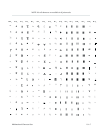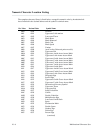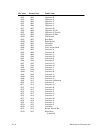
Multinational Character Sets10-2
The selection of the Extended Character Set also sets the print mode and pitch at which the
Extended Character Set is printed. The print mode and pitch can be different for the Primary
and
Extended Character Sets. However, the P
rimary Set
cannot be mixed with an Extended Set
within the same line if the Extended Set is printing at a different print mode than the
P
rimary
Set.
When
ECMA 94 L
atin 1 has
been selected from the control panel, the OSET command can be
sent from the host to then select the extended portion of the character set. More information
on
the OSET command is
provided in
Character Set Select: ECMA 94 Latin 1 Extended,
located
in
the P
rogramming chapter.
OCR-A and OCR-B
OCR
print modes are selected from the P
rint Mode feature at the P
rint F
ormat (L
evel 1) of the
Configuration
Diagram shown in the Configuration chapter.
OCR print modes do not contain complete character sets. (OCR character set charts are loĆ
cated in Appendix B.) Available OCR-A standard characters are dictated by American NaĆ
tional Standard Institute (ANSI) #X3.17-1981, and OCR-A international characters are in
accordance
with International Organization
for Standardization (ISO) #646-1973. A
vailable
OCR-B standard and extended characters are dictated by ANSI #X3.49-1975. Undefined
OCR characters are replaced with spaces. When an international language substitution is seĆ
lected
for a non-existent character, no substitution will occur.
Downloading Languages and Characters
Character
substitution
tables can be customized and stored until needed using two Download
Ć
ing procedures. Using the Downloading a L
anguage feature (ESC V) allows you to define and
download a character substitution table which can be placed within the 224 printable symbol
code
points. Download a Character, activated by ESC
c, allows at least six characters (depend
Ć
ing
on the character size(s)) to be defined and stored in NO
VR
AM. R
efer to
Download a Lan
Ć
guage
and
Download a Character
in the P
rogramming chapter.
The
complete character library is shown in the Character A
ddress T
able on page NO T
A
G. The
character library identifies each character's location in printer memory by its hexadecimal adĆ
dress
value (see the
Numeric Character listing starting on page 10-6 or the Alphabetical Char
Ć
acter listing starting on page 10-18). International language substitutions are retrieved from
this Character Address Table and substituted in the values shown on the international lanĆ
guages
substitution tables. F
or example, while 7E
hex is the L
owercase Beta symbol on the in
Ć
ternational
substitution table for ECMA German, E1 hex is the
actual address of this character
in printer memory. All symbols
are
shown in 10 cpi, and do not represent the symbol in all print
modes
and pitches.
NOTE:
The character examples provided in each character set are representative and not
exact
replications generated by the printer
. In addition, not all characters are available
in
all
print modes.


















